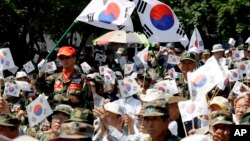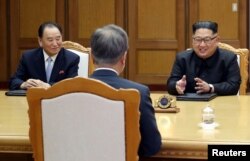When the United States and North Korea hold a historic summit on Tuesday, supporters of former South Korean President Kim Dae-jung say it will be the culmination of a mission launched two decades ago by the Nobel Peace Prize winner.
Kim, who died in 2009, introduced the "Sunshine" policy of engaging with the North in 1998. Although it was later branded a failure by critics, his aides and a son say the Singapore summit could make his dream a reality: lasting peace on the Korean peninsula.
"My father would be extremely delighted if they take steps to realize a permanent peace regime, an opportunity he missed by a hair's breadth," said Kim Hong-gul, his youngest son who currently heads the Korean Council for Reconciliation and Cooperation, a coalition of about 200 civic groups working on inter-Korean peace. "That would complete his lifetime mission."
The policy is named after Aesop's fable about the sun and the wind competing to remove a traveller's coat and how the man
wrapped the coat tightly around him in a blustery wind but threw it off when sun shone on him. The principle of Kim Dae-jung's Sunshine policy was that persuasion was better than force, and that engagement through dialogue and economic and cultural
exchanges would bring about a change in the North and foster peace between the two Koreas.
Kim Dae-jung won the Nobel Peace Prize in 2000 for the first-ever inter-Korean summit since the 1950-53 Korean War with Kim Jong Il, the late father of current North Korean leader Kim Jong Un.
For most of the next decade, the South gave aid and promoted exchanges with the North but the policy began to wane when a North Korean soldier shot and killed a South Korean tourist who strayed into an off-limits area in the North's Mount Kumgang resort in 2008. After Kim Jong Un took power in Pyongyang in 2011, the North has pursued nuclear weapons and ballistic missiles programs, hurling insults and threats at South Korea and the United States.
South Korean President Moon Jae-in, a supporter of the Sunshine policy, has made a fresh effort at detente since he was voted to power in May last year. He has held his own two summits with Kim Jong Un, in April and May.
Moon's efforts to act as a mediator between Kim Jong Un and U.S. President Donald Trump led to Tuesday's summit, and that's the role the late Kim Dae-jung had long sought to play, according to his son and former officials.
Kim Dae-jung, who fought North Korean communist guerrillas during the Korean War, was adamant that there must not be war again on the peninsula, and that the fate of the region should not be left in the hands of superpowers.
After the 2000 inter-Korean summit, Kim Dae-jung convinced then U.S. President Bill Clinton to visit Pyongyang and meet Kim Jong Il, according to memoirs written by Lim Dong-won, the former South Korean president's point man on North Korea.
But the plan soon fell apart following the narrow election victory of George W. Bush, who hardened his line against North Korea with the help of Republican conservatives, he wrote. Lim declined to comment for this story.
Another failure came in 2006, when the North shunned Kim Dae-jung's offer to cross the border as retired president to help break the standoff with Washington over its freeze of about $24 million worth of North Korean funds at Macau's Banco Delta Asia.
Lee Jong-seok, who helped shape the Sunshine policy from the early 1990s and became unification minister in 2006, says he is still "unthinkably sorry and heartbroken" when he recalls Kim Dae-jung's crestfallen face after he told him he would not be able to go.
"It was around the time when conservative, anti-North Korea protesters camping out in front of his home every day," Lee told Reuters.
"But he was so composed and resolute, saying he's old enough not to be afraid of anything if he could contribute to making peace."
Kim had planned to speak at the National Press Club in Washington on Sept. 19, 2009, marking the anniversary of a 2005 aid-for-disarmament accord reached by the six party talks involving the two Koreas, the United States, China, Japan and Russia.
Kim, then 85, was in poor health but was insistent on going. However, he died just one month before the scheduled address. "I delivered the speech on behalf of him, which was virtually his posthumous work," said Chung Dong-young, Lee's predecessor as unification minister.
"And the key message was that a summit between the United States and North Korea would be the only way to resolve the nuclear issue."
Many of the architects of the Sunshine policy, including Lee, advise the Moon administration and were invited to a dinner on the sidelines of the first summit between Moon and Kim Jong Un in April.
Suh Hoon, who was instrumental in arranging the 2000 summit, is now Moon's spy chief and played a key role in pursuing the summit between Kim and Trump.
The "sunshiners" say Moon has prevailed in his efforts because the North's Kim Jong Un is a more confident leader, more keen to meet international standards, than his father.
"Both Kim Jong Un and Jong Il are cavalier, smart, charismatic and humorous but the young Kim is much more westernized and conscious of how others view him, with knowledge of media," said Park Jie-won, a former special envoy of Kim Dae-jung to Pyongyang who has met both the North Korean leaders.
Kim Jong Un has said he is willing to denuclearize and focus on North Korea's economic development. But there is skepticism whether he will suddenly give up an arsenal in which he and his family have invested for decades.
Yet both Kim and Trump have come too far to risk any failure from the summit, and Kim's boldness and Trump's disposition as a dealmaker may come together to produce a surprising result, the former officials said.
"Both sides are coming to the summit out of their own fears and frustration, and we should try to encourage Kim Jong Un, rather than question his intention, so that he can shake off any doubt and take the right path with conviction," Lee said.











